Unraveling the Intricacies of Negative Claiming
In this latest blog post, Neil Kardos brings to light an essential tip about drafting patent claims – the art of sidestepping negative claiming.
Negative claiming occurs when something that doesn’t happen is claimed, a phenomenon that can make patent claim drafting quite convoluted. For instance, consider the situation where your cell phone receives a specific request from a cell tower and usually responds by sending back a message.
However, imagine if the invention introduces a unique twist where the phone, upon detecting a certain condition that the cell tower isn’t aware of, chooses not to respond as per the norm. For instance, the phone may identify that it’s running low on battery or the request is inapplicable for some other reason, leading to the phone’s decision to abstain from responding.
The traditional patent claim language for this scenario might be: “(1) receiving a request, (2) determining that the request isn’t applicable, and (3) not responding to the request?” However, this formulation feels somewhat cumbersome, and patent examiners are known to frown upon such negative limitations.
Neil has developed a handy workaround for these situations – the use of the word “refrain.” This term implies a deliberate decision to abstain from an action or to halt an event, effectively conveying the same meaning without resorting to negative claiming. Thus, in the given example, the claim could be elegantly rephrased as “refraining from transmitting a response to the request.”
Have you discovered other effective strategies to handle such scenarios? If you’ve encountered similar situations and found effective ways to deal with them, we’d love to hear it!
Thanks for reading! Don’t forget to come back for more tips in the next installment of the Practical Patents Series.
Want more tips? Check out other Practical Patents videos with Neil Kardos here!

